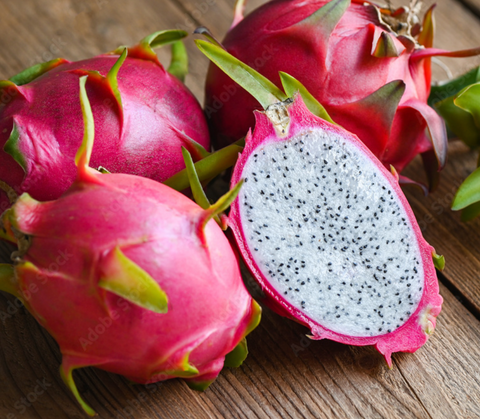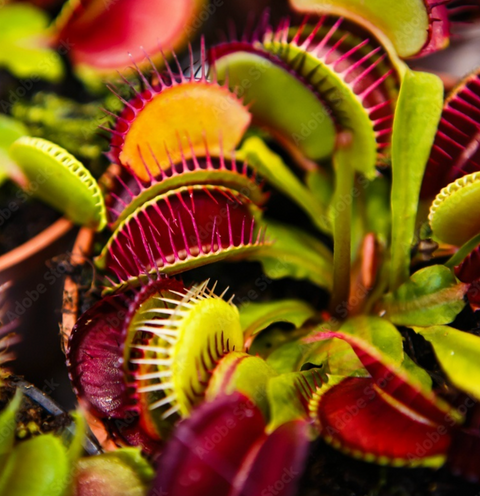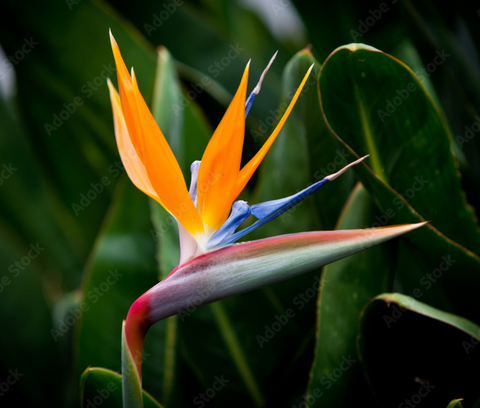Pitaya , also known as dragon fruit, is an exotic plant native to Central America and Mexico. In recent years, it has become increasingly popular due to its unique appearance, refreshing taste and numerous health benefits. Pitaya is not only attractive for its bright pink or yellow fruits covered with characteristic scales, but it is also an interesting plant for home gardeners. In this article, we will explore what pitaya is, how to grow it at home, its properties, characteristics and how to properly water and maintain it.
🌿 What is Pitaya ?
Pitaya (Hylocereus spp.), better known as dragon fruit, is the fruit of a cactus that grows in tropical and subtropical climates.
There are three main types of questions:
- Hylocereus undatus (with white pulp and pink bark),
- Hylocereus costaricensis (with red pulp and pink bark),
- Hylocereus megalanthus (with white pulp and yellow bark).
The plant is a climber and can climb trees, walls, or special supports.
Pitaya is known for its unique appearance and refreshing taste. The fruit is rich in water and has a slightly sweet taste that resembles a combination of kiwi and pear. The fruit is popular in fruit salads, smoothies and desserts, and its low calorie and high fiber content make it a popular choice for those who want to eat healthily.
🌿 Properties and characteristics of Pitaje
Due to its exotic nature and beautiful appearance, the pitaya is a popular plant among tropical plant lovers. Its main characteristics are:
- Tropical cactus: Pitaya is a type of cactus, which means it is adapted to dry conditions and stores water in its stems.
- Night flowering: The plant blooms at night, and the flowers are large and fragrant. Flowering usually begins in the evening and lasts only one night.
- Attractive fruits: The fruits are large, oval and covered with scaly shoots. The rind is pink or yellow and the interior is white or red, with small black seeds.
- Health benefits: Pitaya is rich in antioxidants, vitamin C, fiber, and other nutrients. It aids digestion, boosts the immune system, and is low in calories, making it ideal for a balanced diet.
🌿 How to grow Pito from home ?
Pitaya is a plant that you can grow at home , even though its natural environment is tropical or subtropical. With proper care and attention, you can successfully grow your own dragon fruit at home. Here are the steps and tips on how to grow pitaya at home:
- Choosing the right variety
First, decide which variety of pitaya you want to grow. The most commonly grown pitaya is the pink pitaya with white or red flesh (Hylocereus undatus or Hylocereus costaricensis). You can choose seeds or young plants, which are available at garden centers.
- Preparation from the beginning and the end
Pitaya requires a well-drained, nutrient-rich substrate. It is recommended to use a cactus soil mix that contains sand or perlite to improve drainage. The pot should be large and deep enough because pitaya has a strong root system that needs room to grow.
- Planting and transplanting
You can plant pitaya seeds directly into the substrate, but it is important to cover them lightly with soil and water them regularly until they germinate. If you are planting a young plant, plant it in the center of the container and gently press the soil around the roots. Transplanting is recommended when the plant outgrows its container.
- Light and temperature
Pitaya needs a lot of sunlight, so place it in a sunny spot where it will receive at least 6 hours of direct sunlight per day. The plant thrives best in temperatures between 18 and 30 degrees Celsius, but it can survive slightly lower temperatures, although it cannot tolerate frost.
- Support and feedback
Since pitaya is a climber, it needs support to grow. It is best to use wooden or metal supports that it can climb on. You can shape the plant by pruning it regularly to encourage better growth and fruit formation.
- Watering
Watering pitaya should be regular, but not excessive. Cacti are known for retaining water, so it is important that the substrate dries out a little between waterings. In summer, the plant should be watered more frequently, while in winter, watering is less frequent.
- Fertilization
For better growth and fruit development, it is recommended to fertilize the pitaya with cactus fertilizer or a balanced fertilizer once a month during the growing season (spring and summer). Over-fertilizing can cause root burns, so be careful with the amount.
- Flowering and fruiting
Pitaya blooms at night, and the flowers attract nocturnal pollinators such as bats and nocturnal insects. If you are growing pitaya indoors, it is recommended to hand pollinate the flowers with a brush to ensure fruit development.
🌿 Properties and health benefits of pitaya
Pitaya is not only beautiful to look at and delicious, but it also has numerous health benefits, which is why it is considered a superfood:
- Antioxidants: Pitaya is rich in antioxidants that help fight free radicals in the body and reduce the risk of chronic diseases.
- High fiber content: Pitaya is high in fiber, which promotes healthy digestion and helps maintain body weight.
- Vitamin C: The high content of vitamin C strengthens the immune system and contributes to skin health.
- Low calorie content: Pitaya is a low-calorie fruit, making it ideal for those who want to maintain a healthy body weight.
- Blood Sugar Control: Pitaya can help regulate blood sugar levels, which is beneficial for diabetics.
🌿 Common problems and how to solve them
Some problems may arise when growing pitaya, such as:
- Root rot: If the plant is overwatered, root rot can occur. Prevent this by providing adequate drainage and watering when the soil is dry.
- Spider mites and lice: Pitaja can be attacked by spider mites and lice, which you can get rid of with insecticidal soap or natural preparations.
- Lack of fruit: If your pitaya is not producing fruit, the problem may be with pollination. Try hand-pollination of the flowers or ensure that the plant has enough light and nutrients.
With proper care, proper watering, enough light and support for climbing, the pitaya can thrive even in temperate climates. Although it is a tropical plant, it adapts well to indoor conditions, provided that these conditions are suitable. Enjoying your own innate pitaya fruit is a special pleasure, because you know that the fruit was grown without the use of harmful chemicals and with a lot of love.
Finally, a piece of advice: don't be afraid to experiment. The pitaya is a plant that you can shape to your liking, whether as a bonsai or as a large shrub that adorns your home. In addition to rewarding you with its beautiful fruits, it will also be a stunning decoration that will attract attention and arouse the interest of everyone who sees it.
Although growing pitaya may seem challenging at first glance, this plant will eventually pay off all your hard work and patience. Follow the tips and recommendations above, and it won't be long before you can enjoy juicy, exotic fruits that you've grown yourself at home. Pitaya is definitely one of those plants that brings a touch of tropical paradise to your life, no matter where you live.



